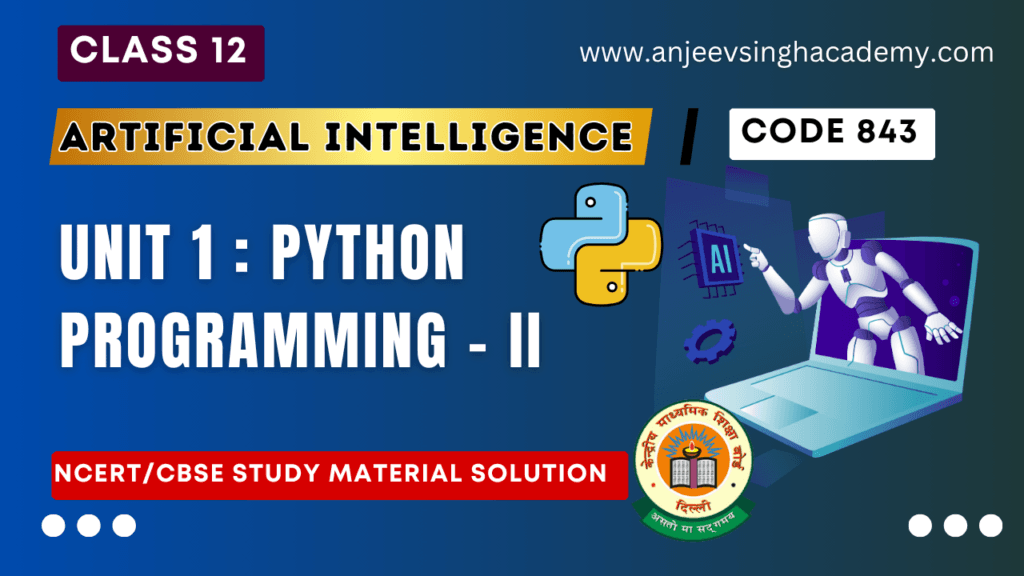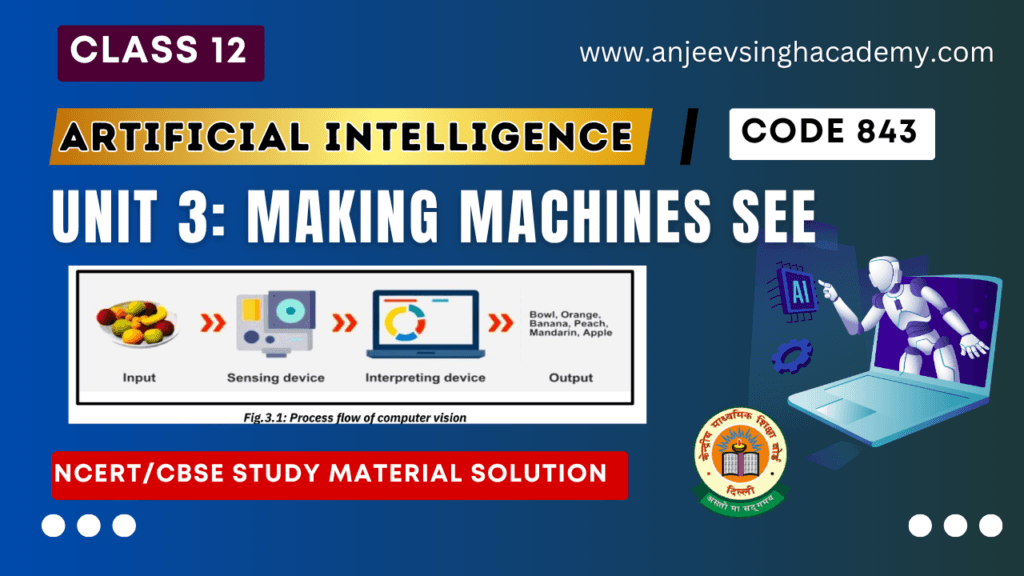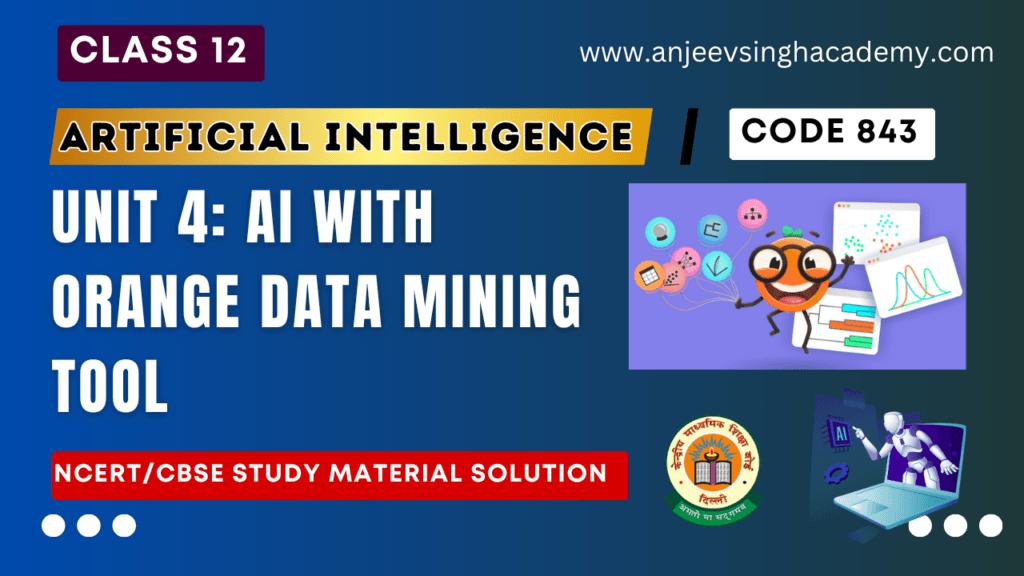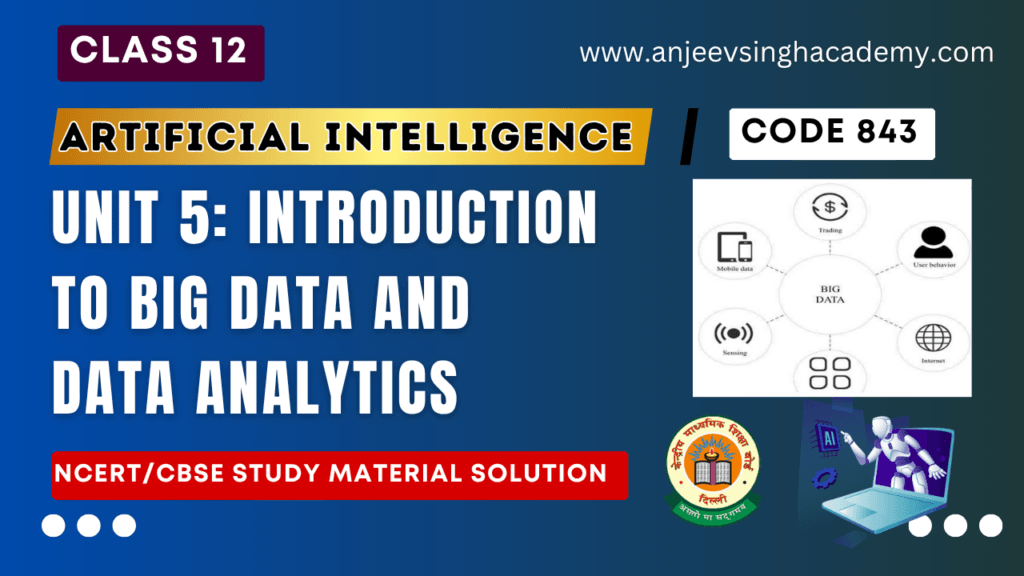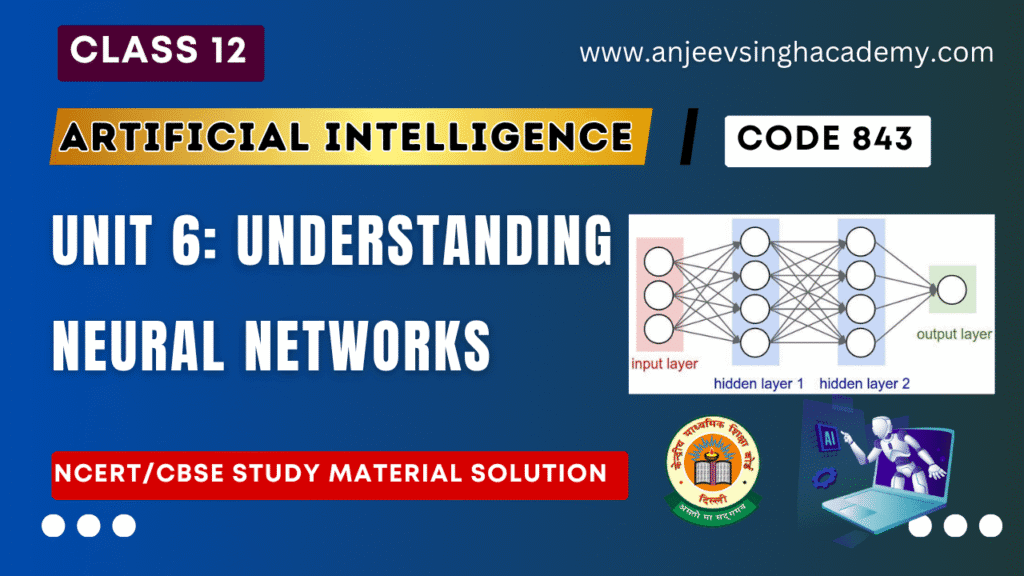Class 12 AI Unit 8 Data Storytelling Book Solution
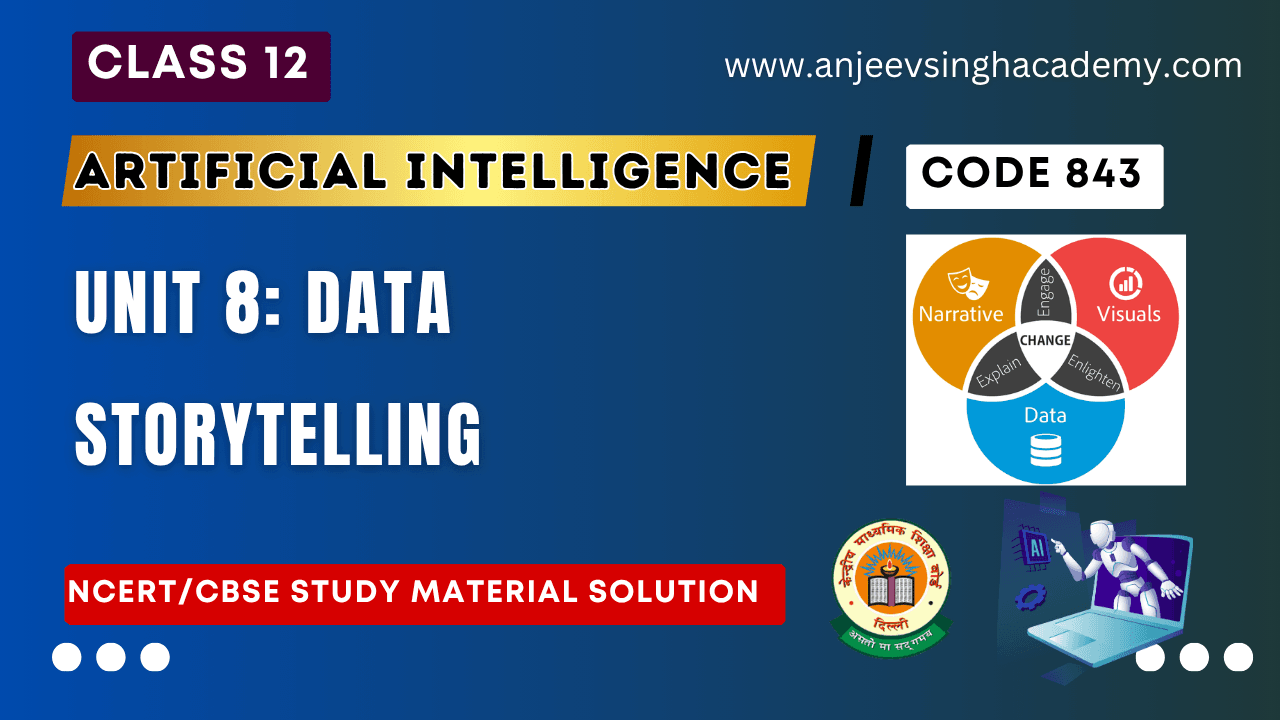
A. Multiple Choice / Objective Type Questions
1. Which of the following best describes data storytelling?
a) Presenting raw data without any analysis
b) Communicating insights through data in a compelling narrative format
c) Creating colorful charts and graphs
d) Analyzing data without any visual aids
Ans: b) Communicating insights through data in a compelling narrative format
2. What is the primary goal of data storytelling?
a) To confuse the audience with complex charts
b) To entertain the audience with anecdotes
c) To communicate insights and findings effectively using data
d) To hide information from the audience
Ans: c) To communicate insights and findings effectively using data
3. Which of the following is NOT a component of effective data storytelling?
a) Compelling visuals b) Clear narrative structure
c) Overcomplicating the message d) Insightful analysis
Ans: c) Overcomplicating the message
4. What role do visuals play in data storytelling?
a) They make the presentation look fancy
b) They distract the audience from the data
c) They help convey complex information quickly and effectively
d) They are not necessary in data storytelling
Ans: c) They help convey complex information quickly and effectively
5. Why is it important to know your audience when creating a data story?
a) To impress them with your knowledge
b) To tailor the message and visuals to their level of understanding and interests
c) To exclude certain data points that might confuse them
d) To ignore their feedback and preferences
Ans: b) To tailor the message and visuals to their level of understanding and interests
B. True False Questions
1. The main purpose of a data visualization is to hide the data from the audience.
Ans: False
2. Sonnet charts are not a common type of data visualization.
Ans: True
3. Data storytelling involves presenting insights and findings in a compelling narrative format.
Ans: True
4. Data storytelling involves presenting raw data without any analysis or interpretation.
Ans: False
5. Data storytelling is only effective if it excludes certain data points that might confuse the audience.
Ans: False
C. Short Answer Type Questions
1. Define Data Storytelling.
Ans: Data Storytelling is a means of delivering facts with a compelling narrative to a specific audience. It uses a structured approach to deliver data insights that includes the three main elements – data, visuals and narrative.
2. What is the difference between conflict and resolution?
Ans- Conflict is the struggle between two or more opposing forces in the story whereas resolution is the end of the story where the characters arrive at a particular situation to resolve the conflict.
3. Name the three elements of Data Storytelling.
Ans– The three elements are – Data, visuals and narrative.
4. Name some graphs which can be used for the following type of data.
a. Text Data b. Data which is changing constantly over a period of time
c. Stocks variation d. Mixed data
Ans:
a. Text data – Word cloud
b. Data which is changing constantly over a period of time – Line chart
c. Stocks variation – Candle stick graph
d. Mixed data – facet grid
5. Name some important ethical concerns related to Data Storytelling.
Ans- The ethical concerns related to each element of Data Storytelling are as follows:
1. Data – accuracy concerns
2. Narrative – transparency concerns
3. Visualizations – fallacy concerns
6. Define insight in storytelling and briefly explain its significance.
Ans – An insight in data storytelling refers to a valuable and meaningful observation or understanding derived from analyzing data. It involves uncovering patterns, trends, correlations, or anomalies within the data that provide actionable information or shed light on a particular issue or problem. Insights in data storytelling help stakeholders gain a deeper understanding of the underlying data and empower them to make informed decisions or take appropriate actions based on the findings.
7. Describe Freytag’s Pyramid and its application in data storytelling.
Ans – Freytag’s Pyramid is a narrative structure with five stages: exposition, rising action, climax, falling action, and resolution. In data storytelling, it serves as a framework to structure the presentation of data and insights, guiding the audience through a compelling narrative journey from introduction to resolution.
8. Discuss the ethical considerations in data storytelling.
Ans – Ethical considerations in data storytelling include privacy and consent, bias and fairness, accuracy and integrity, accountability and respect, and continuous learning. It is important to be transparent about data sources, mitigate biases, ensure data accuracy, use power responsibly, and stay informed about evolving ethical standards.
D. Long answer questions:
1. Why has data storytelling become very powerful nowadays?
Ans- In today’s data-rich world, whoever is using data is expected to understand and use data to make decisions everyday, regardless of position, function or skill set. For digital business, data can serve both as input as well as output. Today, data storytelling is filling a vital gap in the business as well as the technical analytics process between technology and people. By combining an increasingly essential resource—data—with a familiar and time-tested form of communication— storytelling, this skill can help more people translate their insights into action. From a data literacy perspective, once an organization’s people are comfortable with reading and working with data, they should also learn how to communicate insights effectively.
2. Explain the steps to create a Data story.
Ans-: If the data collected is represented in just a series of graphs and charts, it will not serve the purpose to any organization. It should be communicated well with proper narrative, with proper context and meaning, relevance and clarity. The narrative should be able to take the focus of the audience to the correct spot and not miss out on important facts.
To find compelling stories in data sets, the following steps are to be followed:
- Collect the data and organize it.
- Use proper visualization tools to visualize the data.
- Then observe the relationships between the data.
- Finally create a simple narrative which is hidden in the data to be communicated to the audience.
3. What are the different types of data and which type of visualization should we use for which data?
Ans- Data can be broadly classified as Qualitative data and Quantitative data. Under the qualitative data we can nominal data and ordinal data. Under quantitative data , we have discrete data and continuous data. Further this data can come under any of these categories, which are: Text data, Mixed data, Numeric data, Stocks data, Geographic data. Based on the data we are handling we can go for different type of visualizations which are: Word cloud, Facet grid, Line chart, Bar chart, Pie chart, Histogram, Bubble chart, Heat map, Scatter plot, Candle stick, Map chart etc.
E. Case Study Based Questions
Consider each of the given scenarios and answer the MCQs:
1. Case Study:
The marketing team of a retail company conducted a survey to understand customer preferences for product packaging. They collected data on packaging design preferences from customers across different age groups and demographics. Based on the survey results, they created a data storytelling presentation to inform product packaging decisions.
What is the primary objective of the marketing team’s data storytelling presentation?
A) To analyze sales trends of different products.
B) To understand customer preferences for product packaging.
C) To evaluate the effectiveness of marketing campaigns.
D) To track inventory levels of various products.
Ans: B) To understand customer preferences for product packaging.
2. Case Study:
A city government collected data on traffic accidents at intersections to identify high-risk areas and prioritize safety improvements. They analyzed the data to identify patterns and trends in accident occurrence and severity. Subsequently, they developed a data storytelling report to present their findings to city officials and propose targeted interventions.
What is the primary purpose of the city government’s data storytelling report?
A) To analyze public transportation usage.
B) To identify high-risk areas for traffic accidents.
C) To assess air quality levels in the city.
D) To evaluate the performance of road maintenance crews.
Ans: B) To identify high-risk areas for traffic accidents.
3. Case Study:
A healthcare organization conducted a study to analyze patient satisfaction levels at various hospitals within the network. They collected data on patient experiences, wait times, staff responsiveness, and overall satisfaction ratings. Using this data, they created a data storytelling presentation to share insights with hospital administrators and identify areas for improvement.
What type of data did the healthcare organization primarily analyze in their study?
A) Sales data for medical supplies.
B) Patient satisfaction levels at hospitals.
C) Staffing levels at healthcare facilities.
D) Insurance claims data.
Ans: B) Patient satisfaction levels at hospitals.
4. Case Study:
A technology company analyzed user engagement data to understand the effectiveness of its mobile app features. They collected data on user interactions, session durations, and feature usage patterns. Based on the analysis, they developed a data storytelling presentation to guide future app development efforts and enhance user experience.
What was the main objective of the technology company’s data analysis?
A) To measure employee productivity.
B) To understand user engagement with the mobile app.
C) To track inventory levels of hardware components.
D) To evaluate customer satisfaction with tech support services.
Ans: B) To understand user engagement with the mobile app.
5. Case Study:
An educational institution conducted a survey to gather feedback from students on online learning experiences during the COVID-19 pandemic. They collected data on internet connectivity issues, course content satisfaction, and overall learning effectiveness. Using this data, they created a data storytelling presentation to inform future decisions on online course delivery methods.
What motivated the educational institution to conduct the survey and create the data storytelling presentation?
A) To analyze student enrollment trends.
B) To assess campus infrastructure needs.
C) To gather feedback on online learning experiences.
D) To evaluate faculty performance in virtual classrooms.
Ans: C) To gather feedback on online learning experiences.
F. Competency Based Question
1. A sales team at a software company conducted a customer feedback survey to gather insights on product satisfaction, user experience, and feature requests. They collected data on customer ratings, feedback comments, and usage patterns. Based on the survey results, they created a data storytelling presentation to improve product development and customer satisfaction. What did the sales team do to gather insights for product improvement and customer satisfaction?
Ans- The sales team conducted a customer feedback survey, collected data on customer ratings, feedback comments, and usage patterns, and then used the survey results to create a data storytelling presentation.
2. The human resources department at a technology company conducted an employee satisfaction survey to understand workplace culture and job satisfaction. They collected data on aspects like work-life balance, career development, and communication effectiveness. Using the survey results, they created a data storytelling presentation to address employee concerns and enhance overall satisfaction.
a. What is the primary goal of the human resources department’s data storytelling presentation?
Ans- The primary goal is to address employee concerns and improve job satisfaction.
b. What specific areas of employee feedback did the human resources department collect data on?
Ans- They collected data on workplace culture and job satisfaction.
c. How does the human resources department plan to utilize the data storytelling presentation based on the employee satisfaction survey results?
Ans- The plan is to use it to address employee concerns and enhance employee satisfaction.
3. A retail company conducted a customer behavior analysis to understand shopping patterns and preferences. They collected data on purchase history, browsing behavior, and customer demographics. Based on the analysis, they created a data storytelling presentation to improve marketing strategies. How did the retail company use data storytelling to enhance their marketing strategies?
Ans- The retail company used data storytelling to analyze customer behaviour, understand shopping patterns and preferences, and improve marketing strategies based on data-driven insights.
4. A healthcare organization analyzed patient satisfaction survey data to identify areas for improvement in patient care and services. They collected data on patient feedback, treatment outcomes, and facility experiences. How can data storytelling be used for improvement in patient care?
Ans-
- Data storytelling helps healthcare organizations improve patient care by analysing patient feedback and treatment outcomes.
- It provides insights into areas that need enhancement, allowing for data-driven decisions that enhance patient experience and quality of care.
- This approach enables clear communication of findings and actionable recommendations, leading to targeted improvements in patient care and services.
5. A technology company conducted a market analysis to identify emerging trends and customer preferences in the tech industry. They collected data on market share, competitor strategies, and consumer behavior. Through data storytelling, they created a presentation to guide product development and strategic decision-making. How did the technology company leverage data storytelling to inform strategic decision-making?
Ans- The technology company used data storytelling to analyze market trends, understand customer preferences, and guide product development and strategic decision-making processes.

